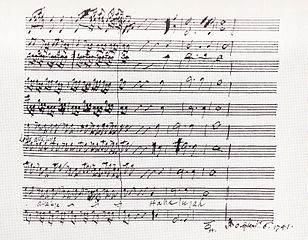Hallelujah Chorus
| Messiah Part II | |
|---|---|
| by George Frideric Handel | |

The last page of the Hallelujah Chorus, ending Part II, in Handel's manuscript
|
|
| Year | 1741 |
| Period | Baroque |
| Genre | Oratorio |
| Text | Charles Jennens, a compilation from the King James Bible and the Book of Common Prayer |
| Composed | 22 August 1741–14 September 1741: London |
| Movements | 23 in seven scenes |
| Vocal | SATB choir and solo |
| Instrumental | |
Messiah (HWV 56), the English-language oratorio composed by George Frideric Handel in 1741, is structured in three parts. This listing covers Part II in a table and comments on individual movements, reflecting the relation of the musical setting to the text. Part I begins with the prophecy of the Messiah and his birth, shows the annunciation to the shepherds and reflects the Messiah's deeds on earth. Part II covers the Passion in nine movements including the oratorio's longest movement, an air for alto He was despised, then mentions death, resurrection, ascension, and reflects the spreading of the Gospel and its rejection. The part is concluded by a scene called "God's Triumph" which culminates in the "Hallelujah Chorus". Part III of the oratorio concentrates on Paul's teaching of the resurrection of the dead and Christ's glorification in heaven.
The libretto by Charles Jennens is entirely drawn from the Bible, mostly from the King James Bible, whereas several psalms are taken from the Book of Common Prayer. The librettist commented: "... the Subject excells every other Subject. The Subject is Messiah ...".Messiah differs from Handel's other oratorios by telling no story, instead offering reflections on different aspects of the Christian Messiah. Christopher Hogwood comments:
...
Wikipedia
